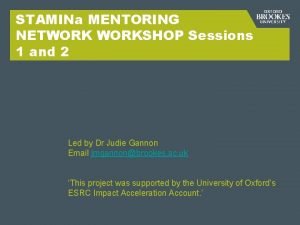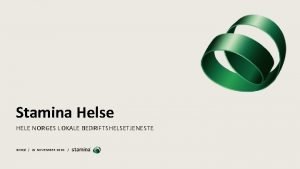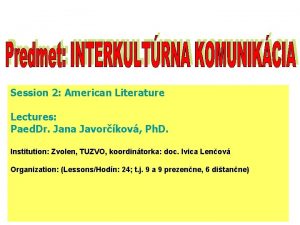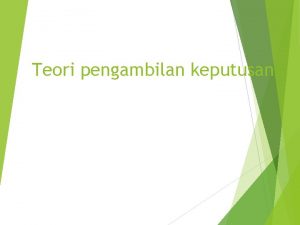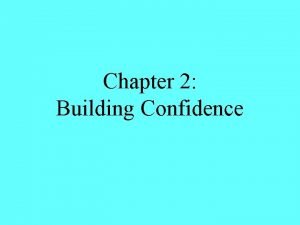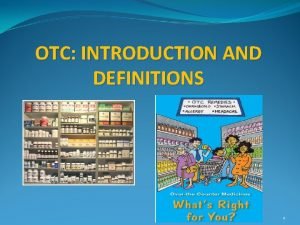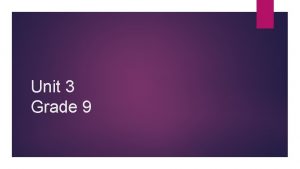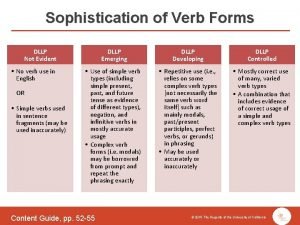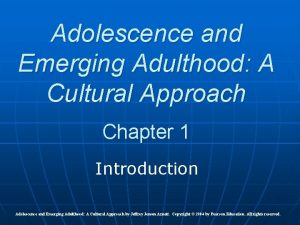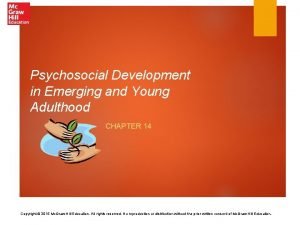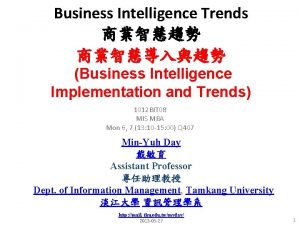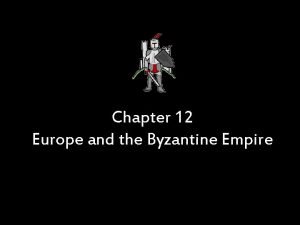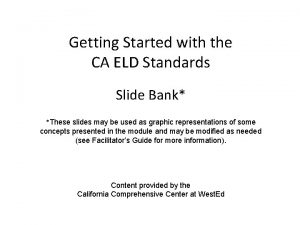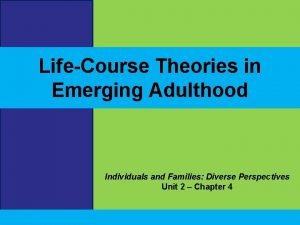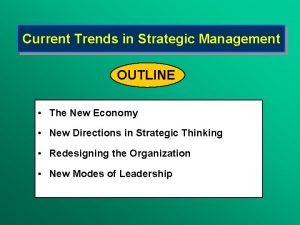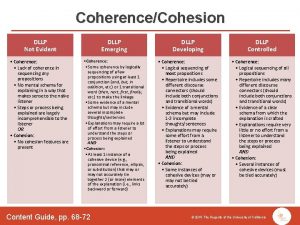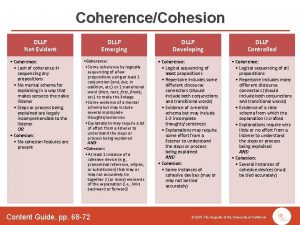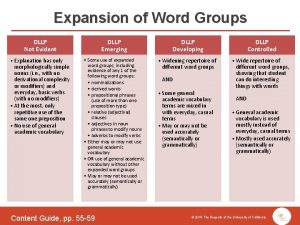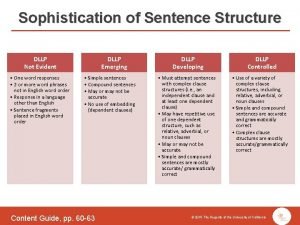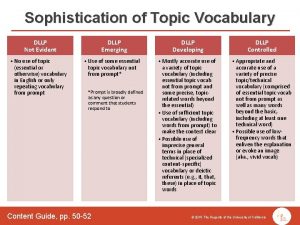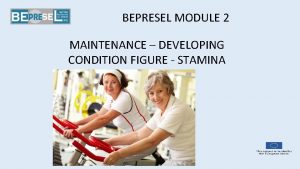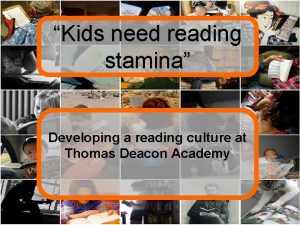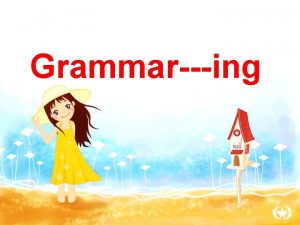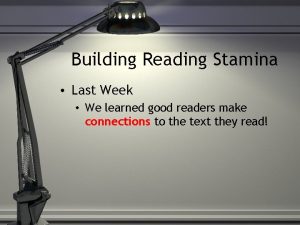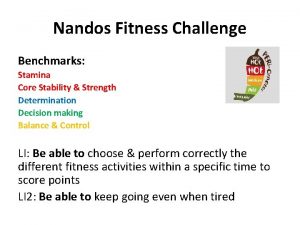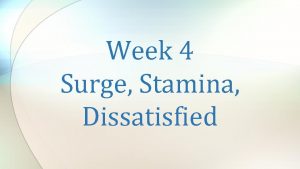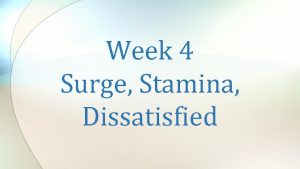Stamina DLLP Not Evident DLLP Emerging DLLP Developing































- Slides: 31

Stamina DLLP Not Evident DLLP Emerging DLLP Developing DLLP Controlled • Response is short and incomplete in terms of expected content for the prompt. That is, the response does not convey that the child has a mental model of the processes being explained • Few to no details (lacking info on specifics of actions, events, thoughts, ideas, such as when, where, with what/whom, how, how often, etc. ) • May abandon response (mid-sentence, mid-detail, mid-idea) • Response may contain retracings and restarts (repetition) of the same information such that meaning-making is difficult • Response is short with some basic aspects of expected content. Mental model of the processes being explained is not fully discernible • May include some details (see Not Evident or Controlled columns) • Response may contain a number of retracings and restarts such that meaning-making is disrupted in a few places • Expanded response that conveys most but not all expected content for the specific prompt. Mental model of the processes being explained is more evident but not completely clear • Includes several expected details (see Not Evident or Controlled columns) • Response may contain a small number of retracings and restarts but meaning-making is not disrupted • Sustained response giving all expected content for the specific prompt. Conveys that the child has a clear mental model of the processes being explained • Conveys actions, events, thoughts, and ideas (etc. ) in detail • Response may contain a small number of retracings and restarts but is fluent and meaning-making is not disrupted Content Guide, pp. 65 -67 © 2015 The Regents of the University of California

Stamina • Along the progression, children gave more elaborated explanations that displayed a clear mental model. Stamina is achieved through children’s sustained attempts to encode their thoughts in sufficiently detailed ways that do not become off-task or too abbreviated for others to extract meaning from their words. Personal routine EL EO/P Developing Stamina (EL): Emerging Stamina (EL): No Evidence of Stamina (EL): Brush your teeth um right. Brush your teeth good. Brush your teeth after when school is done. Brush your teeth after with um um homework time. Brush your brush your teeth only is is good for brushing your teeth. No Evidence of Stamina (EO/P): Researcher: Can you tell him why to do it? Yeah, because you need to and you need However his parents does it, he should do it. to to brush your teeth right. Then his parents should teach him how to do it. That's what I should tell him. • Child’s response does not convey a mental model of the prompt asked. • Response is incomplete and lacks details of the process Not (yet) evident Because you should brush you teeth. And then um if you're done, you put water in your toothbrush and then you start brushing your teeth all over again. Emerging Stamina (EO/P): Researcher: Can you tell them why he should do it? You should do it because you want your Yeah. Because um it's so important. teeth to have no cavities. And as you get older, your parents won't help you. · Includes some details and expected [Now can you tell her how to do it content because she doesn't know how ? ] You brush it like this. And then when you're done brushing it, you just rinse it out. And then if you have fluoride, you do it. Researcher: anything else? Um I don't know what I said. [So tell your friend how to clean his teeth cause he doesn't know how. ] First he gets um his um toothbrush. Then he gets his toothpaste, then the water. Controlled Stamina (EO/P): Then he spits the he he spits up the water. [Anything else? Good. Okay. And can you You should do it because…You should tell him how to do it cause he doesn't brush your teeth because you have to know how? ] know like you don't want any bugs to Brush your teeth. Then. No. Get your make a hole in your teeth. Because you toothpaste. Then you get you put don't want it to hurt when the dentist the toothpaste i- um on your takes them out. And how you brush your tooth- toothbrush. Then you then you get developing Stamina (EO/P): teeth is you take the toothbrush. Put the cup. Then you put water inside it. Then toothpaste. Do the front, the sides, then you you spit it out. You should clean your teeth and um you, to tongue, on top. Wipe your mouth. Put Researcher: And can you tell him why he make to have no cavities and make your stuff away. And then you're done. should do it? teeth clean. And how you do it is that you Because his teeth need to be clean. put toothpaste on your toothbrush, and • Elaboration of expected content and you brush your teeth. And just swish your details · Contains a few instances of retracings mouth with water. And then you're done. • Clear mental schema and restarts and mental model of the Researcher: OK, and is that it? processes · Contains an evident mental model, but still not completely clear · Includes some details, but not a full mental model of the processes Emerging Developing Controlled © 2015 The Regents of the University of California

Stamina No Evidence of Stamina (EL): Brush your teeth um right. Brush your No Evidence of Stamina (EO/P): Personal routine EL EO/P Not (yet) evident teeth good. Brush your teeth after when school is done. Brush your teeth after with um um homework time. However his parents does it, he should do it. Brush your brush your teeth only is is good for brushing Then his parents should teach him how to do it. your teeth. That's what I should tell him. [Can you tell him why to do it? ] Yeah, because you need to and you need to to brush • your teeth right. Lacking in expected steps and detail • Does not exhibit complete mental schema • Lacking in expected steps and detail • Does not exhibit complete mental schema Emerging Developing Controlled © 2015 The Regents of the University of California

Stamina Emerging Stamina (EO/P): Emerging Stamina (EL): Personal routine EL EO/P Not (yet) evident You should do it because you want your teeth to have no Because you should brush you teeth. And then um if cavities. And as you get older, your parents won't help you're done, you put water in your toothbrush and then [Now can you tell her how to do it because she doesn't know you start brushing your teeth all over again. how? ] [Can you tell them why he should do it? ] You brush it like this. And then when you're done brushing it, Yeah. Because um it's so important. you just rinse it out. And then if you have fluoride, you do it. • • Includes some basic aspects of expected content Not a clear mental schema Emerging Developing Controlled © 2015 The Regents of the University of California

Stamina Developing Stamina (EL): Developing Stamina (EO/P): Personal routine EL EO/P Um I don't know what I said. [So tell your friend how to clean his teeth because he doesn't know how. ] First he gets um his um toothbrush. Then he gets his toothpaste, then the You should clean your teeth and um you…to make to water. Then he spits the he he spits up the water. have no cavities and make your teeth clean. And how [Anything else? Good. Okay. And can you tell him how to do it ‘cause he you do it is that you put toothpaste on your doesn't know how? ] Brush your teeth. Then. No. Get your toothpaste. Then you get you put you toothbrush, and you brush your teeth. And just swish put the toothpaste i- um on your tooth- toothbrush. Then you then your mouth with water. And then you're done. you get the cup. Then you put water inside it. Then then you you spit it out. • Lacking some detail [And can you tell him why he should do it? ] Because his teeth need to be clean. • Mental model is more evident but not completely • clear Lacking some detail • Mental model is more evident but not completely clear Not (yet) evident Emerging Developing Controlled © 2015 The Regents of the University of California

Stamina Controlled Stamina (EO/P): Personal routine EO/P You should do it because…You should brush your teeth because you have to know like you don't want any bugs to make a hole in your teeth. Because you don't want it to hurt when the dentist takes them out. And how you brush your teeth is you take the toothbrush. Put toothpaste. Do the front, the sides, tongue, on top. Wipe your mouth. Put stuff away. And then you're done. • Elaboration of expected content and details • Clear mental schema Not (yet) evident Emerging Developing Controlled © 2015 The Regents of the University of California

Stamina • Along the progression, children gave more elaborated explanations that displayed a clear mental model. Stamina is achieved through children’s sustained attempts to encode their thoughts in sufficiently detailed ways that do not become off-task or too abbreviated for others to extract meaning from their words. Academic task EL EO/P Developing Stamina (EL): Emerging Stamina (EL): You need you need to use the cubes to put them in line and then count them before you put them in line. And then you put them in line and then you start piling them more and more until you find out. Researcher: Tell him why using the cubes Developing Stamina (EO/P): this way helps him? Because um you will learn and know Um you lock them up. Then count them. already what is like three plus three or if So you can so then after that you can start you put them in line, you already know counting them with your fingers, and then that there are six in all. when you get the answer right, you can How to use the cube how many they are. Um they're six. Um it's one. And it's two. Three, four, five. Write them on the Emerging Stamina (EO/P): box and then finish each of them again on the back. And then you count how Um uh because she can know that say it out loud. many cubes you have. And you help your there's two. And then she knows there's • Mental schema is more evident but not [Can you tell him why using the cubes other friend to finish um um um. three. And then there's she knows there's completely clear that way helps him figure out how many [Why does using the cubes this way help one more. there are? ] him? ] [And can you tell her how to do it? ] No Evidence of Stamina (EL): Because you can learn more. Um using a lot of cubes to to um collect Ok. Just put them together and then you them and then count all of them. And tell go two, three, six. Yeah. I will do it. · Does not convey all expected content your friend it's six. Or it's one. Six um uh [Okay. And can you tell her why this way [Can you tell her how to do it? ] · Mental schema is more evident but not um. helps? ] No Evidence of Stamina (EO/P): Yeah. You know how to do it. Have some. completely clear Ok. Um cause it helps because you can do [Can you tell your friend how to do it? ] it easy. Cause it's quicker to do. Because I counted. · Not a clear mental schema of how to One, two, three, four, five, six. Includes a couple of retracings Researcher: Uh, uh. Can you tell him why count the blocks. [And can you tell her why this way helps? ] this way helps? For for you can listen in your brain. Because you can see it better when it's · Not a clear mental schema standing up. · Does not complete a mental schema and Begins with a sentence fragment retracings. No complete mental schema • Sentence fragments Not (yet) evident Emerging Developing Controlled © 2015 The Regents of the University of California

Stamina No Evidence of Stamina (EL): No Evidence of Stamina (EO/P): Academic Task EL EO/P Yeah. I will do it. [Can you tell her how to do it? ] Because I counted. Yeah. You know how to do it. Have some. [Can you tell him why this way helps? ] [Can you tell your friend how to do it? ] Because you can see it better when it's One, two, three, four, five, six. [And can you tell her why this way helps? ] standing up. For for you can listen in your brain. • Lacking in expected steps and detail • • Lacking in expected steps and detail Does not exhibit complete mental schema • Does not exhibit complete mental schema Not (yet) evident Emerging Developing Controlled © 2015 The Regents of the University of California

Stamina Emerging Stamina (EO/P): Emerging Stamina (EL): Academic task EL EO/P Um uh because she can know that there's two. And then How to use the cube how many they are. Um they're six. Um she knows there's three. And then there's she knows there's one it's one. And it's two. Three, four, five. Write them on the box and more. then finish each of them again on the back. And then you [And can you tell her how to do it? ] count how many cubes you have. And you help your other friend to Ok. Just put them together and then you go two, three, six. finish um um um. [Okay. And can you tell her why this way helps? ] [Why does using the cubes this way help him? ] Ok. Um ’cause it helps because you can do it easy. ’Cause it's Um using a lot of cubes to to um collect them and then count all of quicker to do. them. And tell your friend it's six. Or it's one. Six um uh um. • • Not (yet) evident Includes some basic aspects of expected content Not a clear mental schema Emerging Developing Controlled © 2015 The Regents of the University of California

Stamina Developing Stamina (EO/P): Developing Stamina (EL): Academic task EL EO/P Um you lock them up. Then count them. So you can so then You need you need to use the cubes to put them in line and then after that you can start counting them with your fingers, count them before you put them in line. And then you put and then when you get the answer right, you can say it out them in line and then you start piling them more and loud. more until you find out. [Can you tell him why using the cubes that way helps him [Tell him why using the cubes this way helps him. ] Because um you will learn and know already what is like three plus figure out how many there are? ] three or if you put them in line, you already know that there are six Because you can learn more. in all. • Does not convey all expected content • Mental schema is more evident but not completely clear Not (yet) evident Emerging Developing Controlled © 2015 The Regents of the University of California

Stamina N/A Academic task Not (yet) evident Emerging Developing Controlled © 2015 The Regents of the University of California

Stamina • Along the progression, children gave more elaborated explanations that displayed a clear mental model. Stamina is achieved through children’s sustained attempts to encode their thoughts in sufficiently detailed ways that do not become off-task or too abbreviated for others to extract meaning from their words. Controlled Stamina (EL): Personal routine EL EO/P Emerging Stamina (EL): He should do it because everybody needs to brush his their teeth to stay healthy. And also so cause they're clean. And we do Because she needs to clean them so they Emerging Stamina (EO/P): it because it's healthy for us and when we could be clean and clean her mouth when we eat, we don't we also need to brush No Evidence of Stamina (EO/P): she's done. I'd tell her she should do it so she doesn't get again and in the night too. He should, because then whatever he eats, (pause) cavities or silver teeth. And how you do it is other people beside him, I don't think That's all. just buy a toothbrush, and put toothpaste · Provides little detail of the process they'll want to sit next to him. And Researcher: Uh. Now can you tell your friend on it. And scrub your teeth. involved in brushing your teeth whenever he talks, the other people will um how to do it? How to brush her teeth? faint. Maybe not faint, but like. She needs to brush here, · No complete clear mental schema of the [And can you explain how he has to clean everything, to get her brush. And when she process of brushing your teeth his teeth? ] she split it, she needs to get some water and With a toothbrush and clean his teeth. put it on her mouth and split it. And that's all. [Anything else? ] No. No Evidence of Stamina (EL): Well you need to get your toothbrush, put some paste and put a little bit of water. And you go up and down with your toothbrush in the teeth. Then right to left. And then you clean your toothbrush and Controlled Stamina (EO/P): put it um oh you take your tongue out and brush your tongue. Then you put you clean Developing Stamina (EL): OK. So you should put. . . you should get a your toothbrush and put it where you put toothbrush and get toothpaste. You take it. Then then you wash your mouth three Um she should do it like um she when she off the cap of the toothpaste and squeeze times and that's how you clean it. Then um when she wakes up and or she goes to some toothpaste out of the tube onto your you need to clean it because there's bed, she has to clean her teeth. First toothbrush. Then you turn on the sink and some germs after you eat. And those putting the toothpaste on the toothbrush. put a little bit of water on your toothbrush. Developing Stamina (EO/P): germs um make your teeth ugly and Then brushing it sideways um circles and And then you put the bristles in your when you talk to someone, you smell bad. top and front and back. And then put a mouth. And you move your hand back and So first I should tell, We should get a Then you need to brush your water and spit the um the toothpaste. Um forth so that you get the toothpaste all toothbrush and we should get toothpaste teeth three times a day: in the morning, um just spit it. over your mouth. And then once you've and spread it on the brush. And then you and after you eat, and at night. Um that's [Anything else? ] done that for about two minutes, you spit scrub it back and forth in your molars and how why you need to brush your That's all. your front teeth. Yeah, that's how. the toothpaste out. And you get some teeth. water, rinse your mouth out and clean [Okay. Oh! Did you tell her why she should [And can you tell her why she should do do it? ] your toothbrush. And you should do that Oh. She should do it because um sh· Explains well content that is expected so that whenever you go to the dentist, Oh, she should do it because she so she when it's picture day, she'll have a nice you don't have cavities, and so that your won't have to go to the dentist and get · Shows indication of mastery of mental um smile. teeth stay healthy. cavities if her teeth turn yellow and get all schema dirty. · Contains a couple of retracings [Anything else? ] · Elaborates details No. · Contains enough details for · Very clear mental schema comprehension · Lacks some detail, however mental schema is comprehensible · No indication of mental schema · Missing steps for comprehension of mental schema Not (yet) evident Emerging Developing Controlled © 2015 The Regents of the University of California

Stamina No Evidence of Stamina (EL): No Evidence of Stamina (EO/P): Personal routine EL EO/P He should, because then whatever he eats, other people beside Because she needs to clean them so they could be clean and clean him, I don't think they'll want to sit next to him. And whenever he her mouth when she's done. . . That's all. talks, the other people will faint. Maybe not faint, but like… [Now can you tell your friend how to do it? How to brush her [And can you explain how he has to clean his teeth? ] With a toothbrush and clean his teeth. She needs to brush here, everything, to get her [Anything else? ] brush. And when she split it, she needs to get some water and No. put it on her mouth and split it. And that's all. • • Lacking in expected steps and detail • • Does not exhibit complete mental schema Not (yet) evident Emerging Developing Controlled © 2015 The Regents of the University of California

Stamina (EL): Stamina (EO/P): Personal routine EL EO/P Because it's important if it stays yellow and it could be very germy. And some students or kids will tease you I'd tell her she should do it so she doesn't get that it's nasty. That you need to clean your teeth cavities or silver teeth. And how you do it is just buy because it's important. a toothbrush, and put toothpaste on it. And scrub [And can you tell her how to do it, because she your teeth. doesn't know how? ] Get a paste and a toothbrush. And that's all. • Includes some basic aspects of expected content Lacking detail • • Includes some basic aspects of expected content • Lacking detail Not (yet) evident Emerging Developing Controlled © 2015 The Regents of the University of California

Stamina Controlled Stamina (EL): Controlled Stamina (EO/P): Personal routine EL EO/P Um she should do it like um she when she um when she wakes up So first I should tell, we should get a toothbrush and we and or she goes to bed, she has to clean her teeth. First putting should get toothpaste and spread it on the brush. And the toothpaste on the toothbrush. Then brushing it sideways um then you scrub it back and forth in your molars and your circles and top and front and back. And then put a water and spit front teeth. Yeah, that's how. the um the toothpaste. Um um just spit it. [Anything else? ] [And can you tell her why she should do it? ] That's all. Oh, she should do it because she so she won't have to go [Okay. Did you tell her why she should do it? ] to the dentist and get cavities if her teeth turn yellow and Oh. She should do it because um sh-when it's picture day, she get all dirty. she'll have a nice um smile. [Anything else? ] • No. Lacking some detail • Mental schema is more evident but not completely clear • Lacking some detail Not (yet) evident Emerging Developing Controlled © 2015 The Regents of the University of California

Stamina Controlled Stamina (EO/P): Controlled Stamina (EL): Personal routine EL EO/P OK. So you should put, you should get a toothbrush and get Well you need to get your toothbrush, put some paste and put a little toothpaste. You take off the cap of the toothpaste and squeeze bit of water. And you go up and down with your toothbrush in the some toothpaste out of the tube onto your toothbrush. Then you teeth. Then right to left. And then you clean your toothbrush and put it turn on the sink and put a little bit of water on your toothbrush. um oh you take your tongue out and brush your tongue. Then you put And then you put the bristles in your mouth. And you move your you clean your toothbrush and put it where you put it. Then then you hand back and forth so that you get the toothpaste all over your wash your mouth three times and that's how you clean it. Then you need to clean it because there's some germs after you eat. And mouth. And then once you've done that for about two minutes, those germs um make your teeth ugly and when you talk to you spit the toothpaste out. And you get some water, rinse your someone, you smell bad. Then you need to brush your teeth mouth out and clean your toothbrush. And you should do that so three times a day: in the morning, and after you eat, and at night. Um that whenever you go to the dentist, you don't have cavities, and that's how why you need to brush your teeth. so that your teeth stay healthy. • Elaboration of expected content and details • Clear mental schema • Clear mental schema Not (yet) evident Emerging Developing Controlled © 2015 The Regents of the University of California

Stamina • Along the progression, children gave more elaborated explanations that displayed a clear mental model. Stamina is achieved through children’s sustained attempts to encode their thoughts in sufficiently detailed ways that do not become off-task or too abbreviated for others to extract meaning from their words. Academic task EL EO/P Developing Stamina (EL): She can count she could count by by by fives 'cause she could learn her fives. And she could know 'cause the number five counting by fives is so easy to count. And she could Developing Stamina (EO/P): um she could learn how um to count by fives. And she's gonna know how Um so you like put the cubes in in a many cubes there are to put in five cubes. group of by their color. And then when And she could count ten, five, ten, fifteen, they're all in the groups, you can count twenty, twenty-five, thirty-five, how many they're in in all. Like, for Because sometimes if you have like forty, forty-five, fifty-five. And she example, they're all then or just count already five and there's one more, you could count more and more. And she could them all up together. could add it with it. And and then and found she could find how many cubes [Can you tell her why this way helps? ] then you figure out your problem. there are in all. So she could learn to count It helps this way because it's more [And can you tell her how to do it? ] by fives and she could find the sum, how Emerging Stamina (EO/P): organized or so you can So if I tell her how to do it, I'll tell her, so many cubes there are. concentrate this way better. And like you first you need to uh add with your favorite Well eh you're going well a good strategy would know what group this thing goes in number, or by fives or by tens. But even is just to start at fives and then do twos. · Contains some instances of retracings if you lose one and then you put it back in numbers but not odd. And then if she That way you can count how many fives · Comprehension is not entirely affected its place. could add them and there's a lot like a lot you have. And then count the twos. left, and there's like not five, she could [Researcher: And can you tell her why this · Lacks certain details of the mental add them. way helps? ] schema Um I think it will really help because · Not a very clear comprehension on the um it's very easy to count by twos and fives. process of counting the cubes Emerging Stamina (EL): No Evidence of Stamina (EL): I could show her. [What would you tell her? Tell her how to do it? ] Counting. [Why does using the cubes this way g. help her? ] So so you could learn. Controlled Stamina (EO/P): You use these cubes and put them by twos. It's funner and faster, more efficient than counting by ones. And yeah. [Can you tell him how to do it? ] You have all the bricks on the Unifix cubes on the right and none on the left. Take two and put them on the left. Do it with another pair until you count two, four, six, eight all the way to the number that the cubes have, which I counted fifty. • Elaboration of expected content and details • Sense of mental schema · Not a clear mental schema · More details are needed · No indication of a mental schema Not (yet) evident Emerging Developing Controlled © 2015 The Regents of the University of California

Stamina No Evidence of Stamina (EL): Academic Task EL I could show her. [What would you tell her? Tell her how to do it. ] Counting. [Why does using the cubes this way help her? ] So so you could learn. • • • Not (yet) evident Lacking in expected steps and detail Does not exhibit complete mental schema Required utterance-by-utterance prompting Emerging Developing Controlled © 2015 The Regents of the University of California

Stamina Emerging Stamina (EL): Emerging Stamina (EO/P): Academic task EL EO/P Because sometimes if you have like already five and there's Well eh you're going well a good strategy is just to one more, you could add it with it. And and then start at fives and then do twos. That way you can you then you figure out your problem. count how many fives you have. And then count the [And can you tell her how to do it? ] So if I tell her how to do it, I'll tell her, so first you need to uh twos. add with your favorite number, or by fives or by tens. But [And can you tell her why this way helps? ] even numbers but not odd. And then if she could add them Um I think it will really help because um it's and there's a lot like a lot left, and there's like not five, she very easy to count by twos and fives. could add them. • • Not (yet) evident Includes some basic aspects of expected content Not a clear mental schema Emerging Developing Controlled © 2015 The Regents of the University of California

Stamina Developing Stamina (EL): Developing Stamina (EO/P): Academic task EL EO/P Not (yet) evident Um so you like put the cubes in in a group of by their color. She can count she could count by by by she could count by by And then when they're all in the groups, you can count how many by fives 'cause she could learn her fives. And she could know 'cause they're in in all. Like, for example, they're all then or just count the number five counting by fives is so easy to count. And she them all up together. could she could um she could learn how um to count by fives. And [Can you tell her why this way helps? ] she's gonna know how many cubes there are to put in five It helps this way because it's more organized or so you can cubes. And she could count ten, five, ten, fifteen, twentyconcentrate this way better. And like you would know what group five, thirty-five, forty-five, fifty-five. And she this thing goes in if you lose one and then you put it back in its could count more and more. And she could found she could find place. how many cubes there are in all. So she could learn to count by fives and she could find the sum, how many cubes there are. • Lacking some detail • Mental schema is more evident but not completely clear Emerging Developing Controlled © 2015 The Regents of the University of California

Stamina Controlled Stamina (EO/P): Academic task EO/P You use these cubes and put them by twos. It's funner and faster, more efficient than counting by ones. And yeah. [Can you tell him how to do it? ] You have all the bricks on the Unifix cubes on the right and none on the left. Take two and put them on the left. Do it with another pair until you count two, four, six, eight all the way to the number that the cubes have, which I counted fifty. • Elaboration of expected content and details • Sense of mental schema Not (yet) evident Emerging Developing Controlled © 2015 The Regents of the University of California

Stamina • Along the progression, children gave more elaborated explanations that displayed a clear mental model. Stamina is achieved through children’s sustained attempts to encode their thoughts in sufficiently detailed ways that do not become off-task or too abbreviated for others to extract meaning from their words. Controlled Stamina (EL): Personal routine EL EO/P Well you first get your toothbrush. Then put some toothpaste in your toothbrush. After, close your mouth. And then do it Controlled Stamina (EO/P): brush it in circles in the back of the teeth Developing Stamina (EL): Emerging Stamina (EL): No Evidence of Stamina (EL): I will like first show her like how I brush my teeth. And then like she when I'm done brushing my teeth, like she could practice No Evidence of Stamina (EO/P): brushing her teeth. And it's good to brush your teeth because when you eat, you So I would tell him that he should clean his don't have that bad breath and that taste teeth because or else he wouldn't really be that you had. And I will tell her what goes able to talk. And then I would say like or he first and second and show her how to would have to go to the dentist's office brush her teeth. And that's it. more. And I would say, "Try to clean every tooth just as a start, nice and easy. And get · Lacks steps and details of the mental in between your teeth. " And yeah. schema Um you the way you brush your teeth, you um you get your toothbrush and you should take a good amount of time Emerging Stamina (EO/P): washing your teeth. A good reason why you should wa- um wash your teeth is so OK. So why you should do it is because you that you won't have cavities, you won't do not want to get cavities because it hurts. have any problems with your teeth, and so And then how you do it is you put the your teeth will look good and be as toothpaste on the toothbrush. You put it in healthy as possible. your mouth and you make little circle patterns on your teeth all around. That's · Instance of retracing how you do it. · Lacks details of the mental schema · Does not meet the expectations for the Developing level You how you have to do it is when you brush your, you have a you put a paste on your toothbrush and you go the back and then you go to the front. I go like that and go back and then go front and Developing Stamina (EO/P): back. And go into the sides and even on the top. And you should brush your teeth Ok uh I would tell my friend that first he because uh actually after you're done with has to brush like his front teeth and then that, you could floss it with floss. It's good his back teeth. And then he can also brush it's great to brush your teeth for you can't like his tongue and the roof of his mouth. : have any cavities or something that [Can you tell your friend why he should that could hurt your teeth. That's it. do it? ] Ok um my friend should brush his or brush · Few instances of retracings her teeth because um then they won't get · Comprehension of the mental schema cavities and they'll have fresh breath. is not completely affected · Lacks significant details · Evidence of comprehension of mental and the front of the teeth, the front teeth. OK. So you first wet your toothbrush, put And then after, open your mouth. And some toothpaste on it, put it in your then wash it where the bottom is at, right mouth. I prefer to put it on the side of my here at the bottom, and then at the back mouth and go across and do the top part of the teeth. And then after, you do the of them, then the backside, then the upper you take out your tongue. And then you side. And you do. . . you scrub it for 20 start going up and down until all seconds each. So do each side for 20 the germs from the tongue takes gets out. seconds each until you've gotten to the far And then you rinse your side and do the next layer. And then once mouth at least three times. And you sh- you're done, you rinse off the toothbrush. you should do it because it is You spit it out. You get a cup, fill it with important. And if you don't do water, and then rinse your mouth. it, then you the food won't taste better [And can you also tell him why he should than it does. And your teeth will rot. And clean his teeth? ] they'll turn yellow. And you won't have a Yeah, you should really clean your teeth perfect smile. Everyone will be scared of because you don't want them to rot and you. Like it'll be a bad thing. you want be able to eat hard stuff. You'll only be able to eat kind of soft mushy • Elaboration of expected content and detailsstuff, like yogurt, I think oatmeal kind of. Yeah, like oatmeal. Sorry about that. So • Sense of mental schema yeah. • Elaboration of expected content and schema details • Sense of mental schema · No indication of mental schema Not (yet) evident Emerging Developing Controlled © 2015 The Regents of the University of California

Stamina No Evidence of Stamina (EL): No Evidence of Stamina (EO/P): Personal routine EL EO/P I will like first show her like how I brush my teeth. So I would tell him that he should clean his teeth And then like she when I'm done brushing my teeth, because or else he wouldn't really be able to talk. like she could practice brushing her teeth. And it's And then I would say like or he would have to go good to brush your teeth because when you eat, you to the dentist's office more. And I would say, "Try don't have that bad breath and that taste that you to clean every tooth just as a start, nice and easy. had. And I will tell her what goes first and second and And get in between your teeth. " And yeah. show her how to brush her teeth. And that's it. • Lacking in expected steps and detail • • Lacking in expected steps and detail Does not exhibit complete mental schema • Does not exhibit complete mental schema Not (yet) evident Emerging Developing Controlled © 2015 The Regents of the University of California

Stamina Emerging Stamina (EL): Emerging Stamina (EO/P): Personal routine EL EO/P Not (yet) evident Um you the way you brush your teeth, you um you get OK. So why you should do it is because you do not want your toothbrush and you should take a good amount to get cavities because it hurts. And then how you do it of time washing your teeth. A good reason why you is you put the toothpaste on the toothbrush. You put it should wa- um wash your teeth is so that you won't have in your mouth and you make little circle patterns on cavities, you won't have any problems with your teeth, your teeth all around. That's how you do it. and so your teeth will look good and be as healthy as possible. • Includes some basic aspects of expected content Lacking in detail • • Includes some basic aspects of expected content • Lacking in detail Emerging Developing Controlled © 2015 The Regents of the University of California

Stamina Developing Stamina (EL): Developing Stamina (EO/P): Personal routine EL EO/P You how you have to do it is when you brush your, you have Ok uh I would tell my friend that first he has to brush like a you put a paste on your toothbrush and you go the his front teeth and then his back teeth. And then he can back and then you go to the front. I go like that and go also brush like his tongue and the roof of his mouth. back and then go front and back. And go into the sides and even on the top. And you should brush your teeth because uh [Can you tell your friend why he should do it? ] actually after you're done with that, you could floss it with Ok um my friend should brush his or brush her teeth floss. It's good it's great to brush your teeth for you can't because um then they won't get cavities and they'll have any cavities or something that could hurt your fresh breath. teeth. That's it. • Conveys most but not all expected content • • Lacking some detail • Mental schema is more evident but not completely clear Not (yet) evident Emerging Developing Controlled © 2015 The Regents of the University of California

Stamina Controlled Stamina (EO/P): Controlled Stamina (EL): Personal routine EL EO/P OK. So you first wet your toothbrush, put some toothpaste on it, put it Well you first get your toothbrush. Then put some toothpaste in your mouth. I prefer to put it on the side of my mouth and go toothbrush. After, close your mouth. And then do it brush it in circles in across and do the top part of them, then the backside, then the upper the back of the teeth and the front of the teeth, the front teeth. And side. And you do. . . you scrub it for 20 seconds each. So do each side then after, open your mouth. And then wash it where the bottom is at, for 20 seconds each until you've gotten to the far side and do the next right here at the bottom, and then at the back of the teeth. And then layer. And then once you're done, you rinse off the toothbrush. You after, you do the you take out your tongue. And then you start going up and down until all the germs from the tongue takes gets out. spit it out. You get a cup, fill it with water, and then rinse your mouth. And then you rinse your mouth at least three times. And [And can you also tell him why he should clean his teeth? ] you sh- you should do it because it is important. And if you Yeah, you should really clean your teeth because you don't want them don't if you don't do it, then you the food won't taste better than it does. to rot and you want be able to eat hard stuff. You'll only be able to And your teeth will rot. And they'll turn yellow. And you won't have a eat kind of soft mushy stuff, like yogurt, I think oatmeal kind of. Yeah, perfect smile. Everyone will be scared of you. Like it'll be a bad thing. like oatmeal. • Elaboration of expected content and details • Clear sense of mental schema Not (yet) evident Emerging Developing Controlled © 2015 The Regents of the University of California

Stamina • Along the progression, children gave more elaborated explanations that displayed a clear mental model. Stamina is achieved through children’s sustained attempts to encode their thoughts in sufficiently detailed ways that do not become off-task or too abbreviated for others to extract meaning from their words. Academic task EL EO/P No Evidence of Stamina (EL): Well basically they would have to be a starter. 'Cause they can't just be like if they were like in kinder, they first have to be counting with by ones 'cause they don't know what times table is. You learn how to add in kindergarten. Well basically that year if they are in first grade they're gonna learn advanced at adding so they probably just wanna start as one. Like one, two, three, four, five, six. You get my point. [Can you tell them why using the cubes this way helps? ] Helps them or helps who? [How it could help them? ] They could learn how to count even more faster. Yeah. Controlled Stamina (EL): Developing Stamina (EL): Emerging Stamina (EL): Um just put them in equal rows this way and that way. And like just make sure and when you're done, just count how many are here and how many are Emerging Stamina (EO/P): here. So that uh it'll and then once you times them, it'll be quicker Um just put them in equal rows and more efficient and you will get the this way and that way. And like just make answer. sure and when you're done, just count how many are here and how many are here. So · Lacks details of the mental schema that uh it'll and then once you time once · Does not meet the expectations for the you times them, it'll be quicker and more Developing level efficient and you will get the answer. · Lacks details of the mental schema · Does not meet the expectations for the Developing level You first gotta look for the colors and gotta put the colors and make and then make a ten pile. Make one of uh a little straight line and put it as a ten. Put ten of these cubes and make it until ten until you get to the end how much you need, how much you had. And then after, you could count them and then count them if there's Developing Stamina (EO/P): if there's any left, count the leftovers if you need to. Uh um so using you put 'em together I [Can you tell him why this way helps? ] mean you can stick 'em or group them in This will help how much they are and if different ways and sort them into you have any problem of having to different numbers or maybe by color if know what number it could possibly be. If that's what you wanna do. And count your mom asks you how much cubes do them up in the end to get the total. That's you have for mathematical for it. mathematical problem, or I'm thinking [And can you tell why that way helps you that it'll help you with math. helps her? ] Um it's a little more efficient and easier · Lacks significant details maybe easier to figure out and easier to · Evidence of comprehension of mental count. That's it. schema · Lacks significant details · Evidence of comprehension of mental schema OK. Mmmm. (long pause) [Can you tell her how to do it? ] Yeah I could tell her that why don't you put to find out put them how you think you can multiply them, like by twos or fives or tens or six or however you think. And if there's little um they're equal, if each group has the same amount Controlled Stamina (EO/P): of of cubes then you just count them. You don't count them but you multiply Um you should you how you can do it this them or just add them however you want. way? Is that like what you're supposed to And then when you're done counting them do? How? um counting them, after that you that's [How to do it and then why it helps. ] your answer about how many cubes um Um how you do this is you group the cubes you got. So it is important to have it this in tens, stacking one on top of the other. way, so then it's easier instead of you Um and repeat that until all the cubes are counting instead of you going one by one stacked up. And if there's any remainder and counting them one by one. of cubes, then um count those up and try to check your math to see if you have • Elaboration of expected content and anything wrong. And why you should do it details this way is because it's more um organized • Sense of mental schema than just pulling them one by one. • Elaboration of expected content and details • Sense of mental schema Does not include expected content for the prompt Not (yet) evident Emerging Developing Controlled © 2015 The Regents of the University of California

Stamina No Evidence of Stamina (EL): Academic Task EL Well basically they would have to be a starter. 'Cause they can't just be like if they were like in kinder, they first have to be counting with by ones 'cause they don't know what times table is. You learn how to add in kindergarten. Well basically that year if they are in first grade they're gonna learn advanced at adding so they probably just wanna start as one. Like one, two, three, four, five, six. You get my point. [Can you tell them why using the cubes this way helps? ] Helps them or helps who? [How it could help them? ] They could learn how to count even more faster. Yeah. • Not (yet) evident Does not include expected content for the prompt Emerging Developing Controlled © 2015 The Regents of the University of California

Stamina Emerging Stamina (EL): Emerging Stamina (EO/P): Academic task EL EO/P So I like doing it this way because it’s very easy. And and there are light and some are dark. I could do the light Um just put them in equal rows this way and that ones and then do the dark ones. And what was the other way. And like just make sure and when you're done, just question? count how many are here and how many are here. So that [How you find out how many cubes there are. ] uh it'll and then once you times them, it'll be I count them one by one and sometimes I see quicker and more efficient and you will get the answer. like a pattern, like going by tens sometimes, and then I go by twos and sometimes by threes. And that’s it. • Includes some basic aspects of expected content • • • Not (yet) evident Mental model of the process being explained is not Lacks detail fully discernible Mental model of the process being explained is not fully discernible Emerging Developing Controlled © 2015 The Regents of the University of California

Stamina Developing Stamina (EL): Developing Stamina (EO/P): You first gotta look for the colors and gotta put the colors and make and then make a ten pile. Make one of uh a little straight line and put it as a ten. Academic task EL EO/P Uh um so using you put 'em together I mean you can stick 'em Put ten of these cubes and make it until ten until you get to the end how or group them in different ways and sort them into different much you need, how much you had. And then after, you could count them and then count them if there's any left, count the numbers or maybe by color if that's what you wanna do. And leftovers if you need to. count them up in the end to get the total. That's it. [Can you tell him why this way helps? ] [And can you tell why that way helps you helps her? ] This will help how much they are and if you have any problem of having Um it's a little more efficient and easier maybe easier to figure having to know what number it could possibly be. If your mom asks you how out and easier to count. That's it. much cubes do you have for mathematical problem, or I'm thinking that it'll help you with math. • • • Lacking some detail Mental model of the process being explained is more evident but not completely clear Not (yet) evident Emerging Developing Controlled © 2015 The Regents of the University of California

Stamina Controlled Stamina (EL): Controlled Stamina (EO/P): Academic Task EL EO/P OK. Mmmm. (long pause) Um you should you how you can do it this way? Is that like what [Can you tell her how to do it? ] you're supposed to do? How? Yeah I could tell her that why don't you put to find out put them [Mmhmm. How to do it and then why that way helps. ] how you think you can multiply them, like by twos or fives or tens or six or Um how you do this is you group the cubes in tens, stacking one however you think. And if there's little um they're equal, if each group has the on top of the other. Um and repeat that until all the cubes are same amount of of cubes then you just count them. You don't count stacked up. And if there's any remainder of cubes, then um count them but you multiply them or just add them however you want. And then those up and try to check your math to see if you have anything when you're done counting them um counting them, after that you that's your answer about how many cubes um you got. So it is important to have it wrong. And why you should do it this way is because it's more um this way, so then it's easier instead of you counting instead of you going one organized than just pulling them one by one and counting them one by one. • Elaboration of expected content and details Clear sense of mental schema • • Clear sense of mental schema Not (yet) evident Emerging Developing Controlled © 2015 The Regents of the University of California
 Stamina mentor
Stamina mentor Stamina helse bodø
Stamina helse bodø Self-evident
Self-evident Gaya pemikiran self evident truth
Gaya pemikiran self evident truth When is stage fright most evident
When is stage fright most evident Behold these truths to be self evident
Behold these truths to be self evident It is evident that want peace
It is evident that want peace Tamper-evident packaging examples
Tamper-evident packaging examples Disrespectful synonym
Disrespectful synonym History of quantum dots
History of quantum dots Verbs of sophistication
Verbs of sophistication We hold these truths to be self evident
We hold these truths to be self evident Sudden and violent but brief; fitful; intermittent
Sudden and violent but brief; fitful; intermittent Emerging technology roadmap
Emerging technology roadmap Adolescence and emerging adulthood a cultural approach
Adolescence and emerging adulthood a cultural approach Emerging trends in business intelligence
Emerging trends in business intelligence 8 emerging technologies
8 emerging technologies Emerging media definition
Emerging media definition Psychosocial development in young adulthood
Psychosocial development in young adulthood Emerging trends in business intelligence implementation
Emerging trends in business intelligence implementation Emerging technology chapter 4
Emerging technology chapter 4 The byzantine empire and emerging europe
The byzantine empire and emerging europe Land bank funding for emerging farmers
Land bank funding for emerging farmers Bridging emerging expanding
Bridging emerging expanding It infrastructure and emerging technologies
It infrastructure and emerging technologies Contcloud
Contcloud Emerging technology advisors
Emerging technology advisors Challenges of emerging trends in operating systems
Challenges of emerging trends in operating systems Levinson's stages
Levinson's stages Current trends in strategic management
Current trends in strategic management Emerging issues in taxation
Emerging issues in taxation Trs ppms pay
Trs ppms pay
